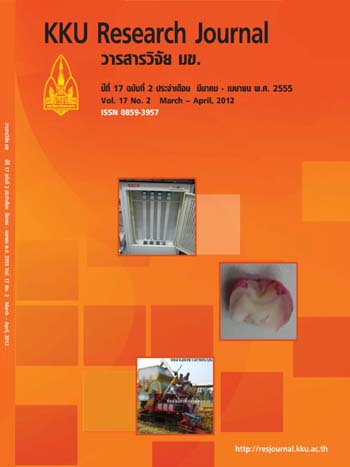Effects of sulfate fertilizer on rice yield cv. Sakon Nakhon and global warming potential
Main Article Content
Abstract
Ammonium phosphate sulfate fertilizer (16-20-0, 42% SO4) is widely used by the Thai rice farmers.
Sulfate’s inhibition of methanogenesis in fl ooded paddy soil has been reported by many scientists in previous
years. This study aimed to investigate the effect of different rates of sulfate (SO4) on rice yield, seasonal methane
emission (SME) and global warming potential (GWP). The experiment was conducted in a farmer’s rice fi eld in
Khon Kaen, Northeast Thailand, during the dry season of 2011. Ammonium phosphate sulfate fertilizer was used
as the main source of sulfate at the rates of 0, 100, 200, and 300 kg SO4 ha-1. All plots with SO4 were adjusted
to have the same amount of N, P2O5 and K2O. The control plot had neither SO4 nor fertilizers. The experiment
was laid out in randomized complete block design (RCBD) with four treatments and three replications. Methane
emissions were measured in one week intervals during the growing season, and calculated as SME and GWP.
Rice yields were also measured. The results showed that the application of fertilizer containing SO4 gave higher
yields with a range of 7.7 – 8.4 t ha-1; four times that of the control with no fertilizer. The application of sulfate
had no distinguishable effect on SME and GWP reduction in silty-clay rice soil.


